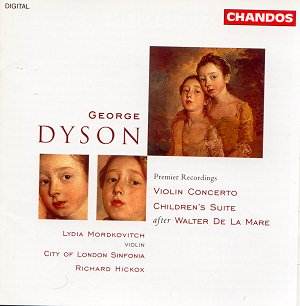GEORGE DYSON
Violin Concerto. Children's Suite after Walter de la Mare.
 Lydia Mordkovitch (violin)
Lydia Mordkovitch (violin)
City of London Sinfonia, Richard Hickox.
 Chandos CHAN 9369 (DDD)
(62.23)
Chandos CHAN 9369 (DDD)
(62.23)

Why have we had to wait so long for a recording of this fine concerto?
How many versions of the Elgar Violin Concerto are currently available
or of the Britten? How many of the Dyson? This Dyson concerto is vastly superior
to both of these.
I have never explored the music of George Dyson. I cannot say why, but I
regret my failure. The opening orchestral passage of this concerto is one
of the most moving and heart-warming "preludes" I have heard in a very long
time. It could stand on its own as a short orchestral work in its own right.
The orchestration is flawless and Hickox brings the best of his players without
being mawkish. Simply lovely music. Enter the violinist with her impeccable
tone and intonation. The opening solo does meander a bit but listen to the
wonderful playing. You won't hear better. The movement is marked molto
moderato and last for 20 minutes. It is a long slow movement. Parts of
it are mere padding but it is a very pleasant sound and contains some wonderful
music. The peaceful England of a bygone ago is in this concerto.
Dyson was born in 1883, the year of Wagner's death and lived to 1964. He
was discovered by that excellent teacher, Charles Villiers Stanford and later
studied in Italy, Vienna, Berlin and Dresden. This working class boy from
Halifax served as an infantryman in the First World war and wrote a treatise
on fighting with grenades.
What other British composer was an expert on an aspect of fighting?
Dyson eventually became director of music at Winchester School and was an
encouragement to many students. He himself was encouraged in composition
by a student at Winchester by the name of Humphrey Searle when Dyson was
finding that his educational reponsibilities was dictating his life. His
Symphony in G of 1937 was not well recieved and had deterred him somewhat.
This was after successes with choral works such as The Canterbuy Pilgrims
(1930), St Paul's Voyage to Melita (1933) and Nebuchadnezzar
(1935). These works were suppressed in favour of the choral works of
Elgar which works do not have jthe finesse or craftsmanship of Dysons.
His Violin Concerto dates from 1941, while he was director at the
Royal College of Music, and Dyson was less than happy with it. Searle urged
him to present it to the public and Sir Adrian Boult
, who did not care for the Symphony,
eagerly took it up. The second movement is a fizzing scherzo, very well
written and perfectly played on this recording. The slow movement is marked
poco andante and is choice. It is very tender. Do listen to that perfect
playing by Ms Mordkovitch. It is simply ravishing. As with the Bax Concerto
there is introduced a passage in three time which sounds banal and spoils
it for me. Somehow waltz sections in symphonic works do not work as far as
I am concerned. The finale is vigorous and celebratory and full of optimism
in the dark days of the Second World War.
I feel the concerto is too long and overstated despite it being very attractive.
Ms Mordkovitch is superb. That is undeniable. Hickox is a good conductor.
He is not in the same class as Bryden Thomson and there are orchestral details
that could have been brought out.
The De La Mare Suite is for small orchestra. It is comparatively trite.
The first movement is slight and introduces a waltz. If you want to hear
great music of a felicitous nature you turn to the genius of Mendlessohn.
The second movement, Pastorale, is a conscious imitation of the greatest
master of them all. Mendlessohn is imitated again in the March and
the finale is a Waltz.
Certainly not great music, and not original either, but perhaps Dyson did
not want it to be such.
David Wright
Performances
Soloist

Orchestra

Recording
